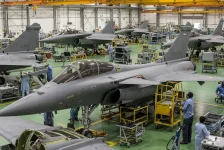- Views: 3K
- Replies: 9
Mazagon Dock Shipbuilders Limited (MDL) is on the verge of signing a landmark contract this June 2025 to construct three additional Kalvari-class submarines for the Indian Navy.
The deal, valued at an estimated ₹38,000 crore (approximately US$4.5 billion), represents a major advancement in India's underwater defence capabilities and a significant boost to the nation's Aatmanirbhar Bharat initiative, promoting self-reliance in defence manufacturing.
These new submarines, to be developed in partnership with France’s Naval Group, will be equipped with advanced technologies.
A key feature will be an indigenously developed Air Independent Propulsion (AIP) system, which will significantly enhance their operational effectiveness compared to earlier submarines of the same class. The AIP system allows submarines to remain submerged for longer periods, thereby increasing their stealth and operational range.
The Kalvari-class submarines, derived from the French Scorpene design, are diesel-electric attack submarines renowned for their quiet operation, adaptability, and sophisticated combat systems.
They are armed with long-range guided torpedoes and anti-ship missiles, making them proficient in a variety of naval operations including anti-submarine warfare, anti-surface ship warfare, intelligence gathering, and surveillance in coastal (littoral) waters.
The Indian Navy has already inducted five of the six submarines ordered in 2005 under Project 75. The sixth submarine from that order, INS Vagsheer, was commissioned on January 15, 2025.
The planned addition of three more advanced Kalvari-class vessels is expected to substantially augment the Navy's operational presence and deterrent power, particularly in the strategically important Indian Ocean Region, where India aims to counter growing maritime competition.
This acquisition is considered urgent as the Indian Navy moves to modernise its submarine fleet, with several of its older Russian-origin Kilo-class submarines approaching the end of their operational service.
The enhancement of India's submarine strength is viewed as a strategic imperative to ensure regional maritime security, especially considering the naval assets of neighbouring countries and the increasing naval activities in the Indian Ocean.
The three new Kalvari-class submarines will be larger and incorporate more advanced features than those currently in service.
A notable improvement is the integration of a fuel-cell-based AIP system, developed by DRDO. This innovative system generates hydrogen fuel as needed, removing the requirement for storing hydrogen onboard and extending the submarines' underwater endurance from approximately 48 hours to an estimated 14 to 21 days. This greatly enhances their capacity for covert and long-duration missions.
Unlike the existing six submarines, which are slated for AIP retrofitting during their mid-life upgrades (starting with INS Kalvari scheduled for September 2025), the new submarines will have the AIP system built into them from the construction stage.
Furthermore, these next-generation submarines will boast advanced electronics, upgraded navigation and communication suites, and an indigenous combat management system developed by Bharat Electronics Limited (BEL).
Promoting domestic industry, the project aims for at least 60% indigenous content, thereby involving numerous Indian suppliers and micro, small, and medium enterprises (MSMEs). This approach is expected to foster local industrial growth and facilitate technology transfer.
The larger dimensions of the new submarines, comparable to Brazil’s Riachuelo-class, along with the use of lithium-ion batteries, will further improve their operational range and endurance, potentially enabling missions extending as far as the waters around Australia.
MDL has indicated its commitment to delivering the first of these three advanced submarines within six years of the contract being signed. Construction is anticipated to commence approximately 18 months after the agreement is finalised, with the first new submarine projected for rollout by 2030.
This represents an accelerated production timeline compared to the nearly 10 years it took for each of the earlier submarines, reflecting MDL's enhanced shipbuilding expertise and optimised processes.
The finalisation of this significant defence deal followed thorough negotiations with the Ministry of Defence. It was reported earlier this year that the Cabinet Committee on Security was expected to clear the project by late January or early February 2025, with the formal contract signing anticipated to have occurred during Prime Minister Narendra Modi’s visit to France on February 11-12, 2025, leading up to the procedural signing with MDL this month.



